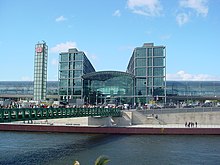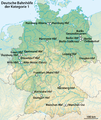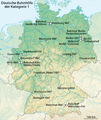Price range
The price class (up to 2017 station category ) of DB Station & Service , a subsidiary of Deutsche Bahn AG , uses various factors to classify the importance of a station or a stop for passenger transport and the service that is offered there. The price classes are included in the station price list of DB Station & Service AG.
history
Already in the provincial railroad period in Germany was the station class in use, in which stations according to their importance in personal and classified freight. In the official station directory of 1944, the "rank of the station" of the Deutsche Reichsbahn appears in four levels with Roman numerals (I. = station, 1st class to IV. = Station, 4th class), followed by nine further classifications as a stop, a stop, and a loading point , Transshipment point, extension or auxiliary point. A fifth train station class (Roman V) was added before 1955. Later these station classes lost their importance.
In the 2000s, Deutsche Bahn modified its station price system , according to which the costs for train stops in stations were determined, and introduced a system of initially six station categories into which DB Station & Service divided its stations, officially differentiating according to their importance for passenger transport ("long-distance traffic node", "long-distance traffic system stop", "regional traffic node" etc.).
This classification was still not understandable for outsiders, so the Duisburg main station was downgraded from category 1 to category 2 after the damage caused by hurricane Kyrill , without any measurement figures having changed. Since this division seemed arbitrary, Deutsche Bahn had to modify the system at the instigation of the Federal Network Agency .
As of 2011, the approximately 5400 train stations and stops were divided into seven categories, the classification of which is based on several criteria, including the number of platforms, train stops and passengers per day, accessibility and the availability of service facilities. Each station is classified into six criteria in levels, from which a basic categorization number is determined, which can reach a maximum of 100, with the levels being weighted as a percentage. The station category results from an interval in which the determined basic categorization number falls.
In December 2017, the station categories were replaced by price classes, whereby the price classes correspond to the previous categories.
The price classes form the basis for determining the station prices that the railway companies (EVU) pay to DB Station & Service and other railway infrastructure companies of the DB Group for the use of their platforms and stops .
Price ranges
DB Station & Service divided the stations into seven categories in the 2011 categorization system, which have been referred to as price classes since December 2017. The number of the respective stations refers to the status of January 2015.
Determination of the price range
| step | Platform edges | Platform length | Travelers / day | Train stops / day | service | Technical steplessness |
|---|---|---|---|---|---|---|
| (0) | - | - | - | - | No | No |
| 1 | 1 | up to 90 m | to 49 | until 10 | Yes | Yes |
| 2 | 2 | > 90 to 140 m | 50 to 299 | 11 to 50 | - | - |
| 3 | 3 to 4 | > 140 to 170 m | 300 to 999 | 51 to 100 | - | - |
| 4th | 5 to 9 | > 170 to 210 m | 1,000 to 9,999 | 101 to 500 | - | - |
| 5 | 10 to 14 | > 210 to 280 m | 10,000 to 49,999 | 501 to 1000 | - | - |
| 6th | from 15 | > 280 m | from 50,000 | from 1001 | - | - |
| weighting | 20% | 20% | 20% | 20% | 15% | 5% |
Remarks
- ↑ The length of the longest operating platform counts
- ↑ "Person-operated service", i.e. the presence of an employee
- ↑ see accessibility
From the classification determined using the table above, a percentage is calculated as follows:
Example for a train station with 4 platform edges of max. 250 meters in length, 20,000 passengers and 280 train stops a day, without employees present, but with no technical level:
This then results in the class:
| percent | class |
|---|---|
| > 90% | 1 |
| > 80 to 90% | 2 |
| > 60 to 80% | 3 |
| > 50 to 60% | 4th |
| > 40 to 50% | 5 |
| > 25 to 40% | 6th |
| up to 25% | 7th |
With the train path pricing system in 2017, DB Netz also introduced a station category. Long-distance traffic between train stations with more than 50,000 passengers per day, known as metropolitan train stations , fall into the metropolitan traffic category.
class 1
Class 1 includes the most important long-distance train stations in Germany. There are service employees there, and there are a number of shopping opportunities in the station. A total of 21 stations belong to this price range. Berlin , Hamburg , Cologne , Munich and the Ruhr area have several train stations in the highest price range.
2nd grade

87 stations, which are usually important stops in long-distance traffic (served by ICE , Intercity or EuroCity ) in large cities or enable a connection to a large airport, are assigned to price class 2, for example Mainz main station .
Class 3
The 239 stations (as of 2014) in price class 3 are often the central train stations in small to medium-sized cities. These are e.g. B. less important long-distance traffic stops or nodes of regional traffic. There is usually a reception building with shops for groceries and ticket sales. However, service employees are sometimes dispensed with here.
Examples of this are the following stations:
However, there are exceptions, such as the Au (Sieg) train station , which also belongs to class 3, as it is an important hub train station for commuters from the surrounding region, although the place itself has fewer than 300 inhabitants.
Grade 4
Around 630 stations are assigned to price class 4, which often form a node in regional traffic, for example Meiningen train station . The stations, formerly known as “highly frequented local transport system stop / local transport hubs”, are mostly aimed at commuters . Long-distance trains also stop at some of these stations, for example at Ludwigslust train station or at times in Hanover Messe / Laatzen .
S-Bahn stations or stops that are served by one or more lines that run at frequent intervals are also assigned to this class, but this is usually not reflected in better equipment compared to price classes 5 and 6. Examples are the Station Berlin-Lichterfelde West , the train station Leverkusen Mitte or the Binger Central Station .
For years there have been no ticket sales points at many of these train stations either, although main train stations in some cities with almost 100,000 inhabitants also fall into this class, e.g. B. Lünen in Westphalia. In the North Rhine region, the city of Bottrop falls into this price range.
Class 5

Price class 5 stations are often those in smaller cities and numerous district train stations. They are often used by commuters. There are around 1000 stations in this class. Examples include Station Post-Heng , Köln-Holweide Bahnhof or Hohen Neuendorf (b Berlin) Bahnhof .
Grade 6

Price class 6 includes over 2500 stations, mostly in sparsely populated areas, the equipment of which is limited to “the bare minimum”. Examples are Ilmenau station or Glöwen station .
Grade 7
The 900 or so stations in the lowest price range, often “land holdings”, have the fewest number of travelers and mostly only the facilities necessary for a stopping point. Because of the low usage, a barrier-free expansion is not considered necessary. Examples are Zwotental station or Göhrde station .
Italy
The Italian State Railways divide the Italian railway stations into the four categories of Platinum, Gold, Silver and Bronze.
- Platinum: more than 25,000 travelers daily, long-distance travel
- Gold: more than 10,000 travelers daily, long-distance traffic
- Silver: more than 4000 travelers a day, regional traffic also over longer distances
- Bronze: less than 500 travelers, only regional transport
Web links
- The seven station categories. (No longer available online.) In: deutschebahn.com . Deutsche Bahn , 2017, archived from the original on September 22, 2016 ; Retrieved April 19, 2017 .
- Station data. In: deutschebahn.com. Deutsche Bahn, accessed on April 15, 2019 (files from several years are available for download).
- Station price list 2020. (PDF) In: deutschebahn.com. DB Station & Service , accessed on April 17, 2020 .
Individual evidence
- ↑ Station price list 2020 , accessed on January 7, 2020
- ^ Deutsche Reichsbahn (Ed.): Official station directory 1944 . 1944, p. V ( genealogy.net [accessed January 10, 2018]).
- ↑ before the closure of the Siebenmühlentalbahn
- ↑ The station price system SPS 11. (PDF; 772 kB) (No longer available online.) DB Station & Service, November 12, 2012, archived from the original on September 21, 2016 ; Retrieved April 23, 2017 .
- ↑ Introduction of price classes at: Deutsche Bahn AG, accessed on January 3, 2019.
- ↑ Station price list 2018 (PDF; 313 KiB) DB Station & Service AG , December 20, 2017, accessed on January 22, 2018 .
- ↑ Felix Berschin: The train path pricing system 2017 (PDF) on nahverkehrsberatung.de, from February 2015, accessed on November 3, 2016.
- ↑ The seven station categories. (No longer available online.) In: deutschebahn.com. Deutsche Bahn , 2017, archived from the original on September 22, 2016 ; Retrieved April 19, 2017 .
- ↑ La classificazione delle stazioni Ferroviarie ( Memento of 21 April 2012 at the Internet Archive )








